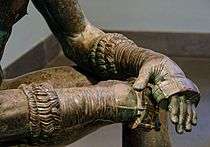Boxer at Rest
_-_Lateral_View.jpg)
The bronze Boxer at Rest, also known as the Terme Boxer or Boxer of the Quirinal, is a Hellenistic Greek sculpture of a sitting nude boxer at rest, still wearing his caestus, a type of leather hand-wrap. It has been given various dates within the period of about 330 to 50 BCE. It was excavated in Rome in 1885, and is now in the collection of the National Museum of Rome, normally displayed in the Palazzo Massimo alle Terme.
Discovery
The Boxer is one of two unrelated bronzes (the other being the unidentified Hellenistic ruler) discovered on the slopes of the Quirinal within a month of each other in 1885, possibly from the remains of the Baths of Constantine. It appears that both had been carefully buried in antiquity. The archaeologist Rodolfo Lanciani, who was present at the sculpture's discovery, wrote
I have witnessed, in my long career in the active field of archaeology, many discoveries; I have experienced surprise after surprise; I have sometimes and most unexpectedly met with real masterpieces; but I have never felt such an extraordinary impression as the one created by the sight of this magnificent specimen of a semi-barbaric athlete, coming slowly out of the ground, as if awakening from a long repose after his gallant fights.[1]
Description
The statue is a masterpiece of Hellenistic athletic professionalism, with a top-heavy over-muscled torso and scarred and bruised face, cauliflower ears, broken nose, and a mouth suggesting broken teeth. R.R.R. Smith believes that the statue does not show a true portrait: this is genre realism, individuality removed in favour of a generic character of "boxer".[2]
In 1989 both bronzes were meticulously conserved by Nikolaus Himmelmann, in preparation for their exhibition at the Akademisches Kunstmuseum in Bonn.[3] The sculpture is soldered together from eight segments, separately cast through the lost-wax process; the joins have been filed and finished to be virtually invisible. The lips and wounds and scars about the face were originally inlaid with copper, and further copper inlays on the right shoulder, forearm, caestus and thigh represented drops and trickles of blood. The fingers and toes were worn from being rubbed by passers-by in ancient times, which has suggested that the Boxer was carefully buried to preserve its talismanic value, when the Baths were abandoned after the Goths cut the aqueducts that fed them.[4]
The statue was displayed in the United States for the first time from June to July 2013 at the Metropolitan Museum of Art in New York City as part of the "Year of Italian Culture in the United States".[5]
Reception
The literary and aesthetic reception of the statue continues to be of high regard for its aesthetic virtues. In 1991, the short story writer Thom Jones wrote "The Pugilist at Rest" as the prize winning, lead short story in a book of his by the same name. The short story includes the aesthetic reflection upon the statue's rare quality as seen through the eyes of a worn and weary boxer contemplating its inspiration. During the time of its display in New York during the summer of 2013 (ended 20 July), New York magazine published on 15 July 2013 a full page dedication to the special qualities and attributes of the statue.
Jerry Saltz, the author of this magazine article enumerated the six distinctive features of the statue as follows: (i) The Pose, distinct for its massiveness and "elemental" form, (ii) The Face, noted for the large brow and columnar neck, (iii) The Blood, noted by its inlaid copper upon the bronze statue itself, (iv) The Scared Genitals, distinct for being infibulated for aesthetic purposes of ancient times, (v) The Hands, noted for being astounding yet gentle at the same time, and (vi) The Foresight, referring to the sculptor's strength of vision which resembles and conjures Goya's Giant as well as comparison with "Velazquez and Rembrandt", as Saltz completes his list.
The author of the short story "The Pugilist at Rest," Thom Jones, suggests the identification of the boxer as follows: "Perhaps it is Theogenes who is depicted in the famous Roman statue (based on the earlier Greek original) of [... the boxer.] The statue depicts a muscular athlete approaching his middle age. He has a thick beard and a full head of curly hair. In addition to the tell-tale broken nose and cauliflower ears of a boxer, the pugilist has the slanted, drooping brows that bespeak torn nerves. Also, the forehead is piled with scar tissue. As may be expected, the pugilist has the musculature of a fighter."
The Italian poet Gabriele Tinti has written essays and some poems on sculpture and presented a series of readings in front of the statue at the J. Paul Getty Museum with the actor Robert Davi and at the National Roman Museum with the actor Franco Nero.[6]
References
 | |
|
|
- ↑ Lanciani, Ancient Rome in Light of Recent Discoveries (1888:305–306), quoted in Sean Hemingway, "The Boxer: an ancient masterpiece comes to the Met", 2013; accessed 29 June 2013.
- ↑ Smith, R. R. R. (1991). Hellenistic Sculpture. London. pp. 54–55.
- ↑ Himmelmann, Nikolaus (1998). Herrscher und Athlet: Die Bronzen vom Quirinal. Milan: Olivetti.
- ↑ Hemingway 2013.
- ↑ "Art - June 2013 - Italy in US 2013: Year of Italian Culture in the United States". italyinus2013.org. Archived from the original on 20 June 2013.
- ↑ https://www.youtube.com/watch?v=379fr-ZlMQQ, National Roman Museum
- ↑ "Apollonius's Boxer at Rest". Smarthistory at Khan Academy. Retrieved February 18, 2013.
External links
| Wikimedia Commons has media related to Boxer of Quirinal. |